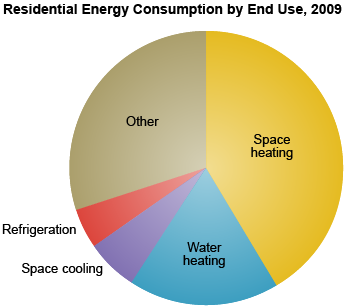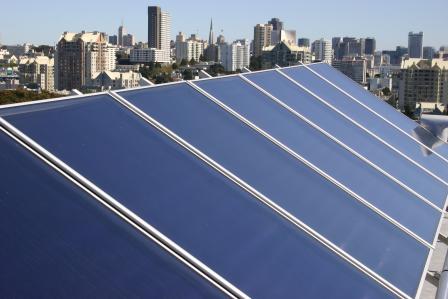RHC for Multi-Unit Housing
- About this sector
- Sector opportunities and challenges for project development
- Costs of RHC technologies

Data source: U.S. Energy Information Administration. 2012. 2009 Residential Energy Consumption Survey. Table CE3.1. Household Site End-Use Consumption in the U.S., Totals and Averages, 2009.
About this Sector
As of 2009, the United States had more than 28 million housing units in multi-unit buildings.1 These multi-unit buildings used a total of 1.6 quadrillion Btu of energy:2
- 0.7 quadrillion Btu on space heating
- 0.3 quadrillion Btu on water heating
- 0.1 quadrillion Btu on air conditioning
The average household in a multi-unit building spends about 61 percent of its energy-related expenditures on heating and cooling, which adds up to about $20 billion per year nationwide.3
Sector Opportunities and Challenges for Project Development
Several factors make multi-family residential buildings good candidates for renewable heating and cooling (RHC) projects:
- The multi-family housing sector is well suited for renewable heating and cooling project development based on the scale, uniformity, and predictability of the energy use profile of individual buildings.
- Unlike single-family homes, multi-family buildings typically involve commercial ownership interests who can take advantage of available tax incentives and commercial depreciation schedules.
- Empirical evidence suggests that many commercial buildings exhibit lower vacancy rates when the building has higher energy and environmental performance. Renewable heating and cooling systems are one of many ways to improve building performance.
- Beyond the heating and cooling loads from residential units, renewable heating and cooling technologies are also well suited to serve multi-unit laundry facilities and pool heating loads.
Renewable heating and cooling projects in this sector also face some challenges:

Credit: SunWater Solar
- Awareness among multi-family building owners regarding the opportunities and benefits of renewable heating and cooling technologies is a primary challenge for development.
- This sector includes many multi-story buildings, which often exhibit small building footprints relative to the building’s heating and cooling load. In some cases, the available space for siting some renewable heating and cooling technologies may be limited.
- Designing and installing renewable systems for buildings with decentralized residential unit-level heating and cooling systems can be challenging, if not technically or economically impractical.
- The “landlord-tenant dilemma” suggests that building owners may be reluctant to make capital investments in renewable heating and cooling projects if they feel they cannot pass the investment costs along to their tenants. These concerns can sometimes be addressed through innovative financing arrangements, or in acknowledging that such investments can have positive impacts on real estate prices, unit rents, and vacancy rates.
Costs of RHC Technologies
The total cost of developing renewable heating and cooling systems can vary based on a number of factors, including the state policy environment, physical geography, available incentives, labor rates, and more. The following cost information is sourced from the National Renewable Energy Laboratory (NREL)4 and should not be interpreted as statistically accurate or sector-specific, but instead should be taken only as rule-of-thumb information and used only for a first-pass screen of economic viability. Visit NREL's website for more detailed information about other costs and typical project lifetimes.
| Technology type | Mean installed cost ($ per square foot) |
Installed cost range (+/- $ per square foot) |
Operation and maintenance cost |
|---|---|---|---|
| Solar water heating: flat-plate and evacuated tube collectors |
$141 | $82 | 0.5 to 1.0% of initial installed cost |
| Solar water heating: plastic polymer collector (unglazed) |
$59 | $15 | 0.5 to 1.0% |
| Technology type | Mean installed cost ($ per ton) |
Installed cost range (+/- $ per ton) |
Operation and maintenance cost |
|---|---|---|---|
| Ground source heat pump | $7,518 | $4,164 | $109 +/- $94 |
| Technology type | Mean installed cost* ($ per kilowatt) |
Installed cost range (+/- $ per kilowatt) |
Fixed operation and maintenance cost ($ per kilowatt) |
|---|---|---|---|
| Biomass wood heat* | $600 | $361 | $91 +/- $33 |
*Biomass wood heat converted from thermal energy capacity (Btu per hour)
- Learn more about solar, geothermal, and biomass technologies.
- Learn more about financial incentives for RHC.
1 U.S. Energy Information Administration. 2012. 2009 Residential Energy Consumption Survey. Table CE3.1 Household Site End-Use Consumption in the U.S., Totals and Averages, 2009.
2 U.S. Energy Information Administration. 2012. 2009 Residential Energy Consumption Survey. Table CE3.1 Household Site End-Use Consumption in the U.S., Totals and Averages, 2009.
3 U.S. Energy Information Administration. 2012. 2009 Residential Energy Consumption Survey. Table CE3.6 Household End-Use Expenditures in the U.S., Totals and Averages, 2009.
4 National Renewable Energy Laboratory. 2013. Distributed Generation Renewable Energy Estimate of Costs. Updated August 2013.
